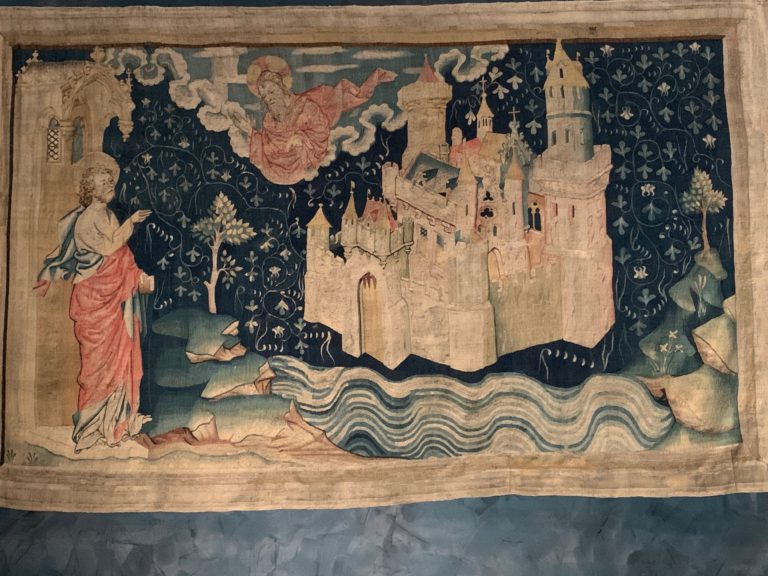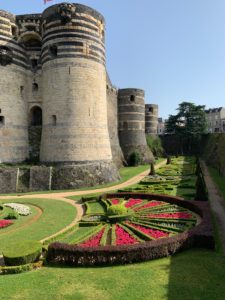God evangelizes in surprising ways

From the top of the castle wall I studied the wide river and its bridges, the cars whizzing along the shoreline past languid boats. Above, brushstrokes of white clouds streaked a blue sky. The air was sharply clean, the height intoxicating. Stepping back from the wall, I continued along the rampart and crossed over a massive stone tower. The medieval heart of the French city of Angers came into view, a tight mosaic of church spires and rooftops. I stopped again and leaned against the wall to peer down at the drawbridge. My route would pass more towers, seventeen in all.
Angers is southwest of Paris, and I was there with my youngest sister this past summer—she was working on her master’s degree in French. In the morning we left her host’s house, she to the university and I to explore the city and countryside. We returned in time for supper, where I routinely fell quiet at the table as she and our host raced along in French. On the weekends, we went exploring; we hadn’t had such unfettered time since childhood.
Like other French cities, Angers (ahn-zhay) boasts an old and charming center from which the city grew outward and spread across the river. It has art museums, a theater, bus and bike lanes, half-timbered medieval houses, and even Benoit Chocolats vending machines. Cointreau, the orange-flavored liqueur, is produced here. You may recognize it as an ingredient in the margarita, a drink, Monsieur Alfred Cointreau claims, that gained its name when Margaret Sames, a wealthy Dallas socialite, served it in 1948 at her villa in Acapulco. Margaret’s margarita.

The city’s pride is the castle, le Château d’Angers, founded more than a thousand years ago. Its elaborate stonework is countered by gardens of incredible variety: topiary archways of yew, fragrant red roses, rows of hydrangeas covered in blooms, an allée of lime trees, a hanging garden with medicinal herbs, grassy lawns, a small vineyard. There is a cathedral and a tiny palace, a petite châtelet. And at the castle’s heart, in an underground gallery, is its most precious treasure: The Apocalypse Tapestry, the oldest medieval French tapestry in the world. Monumental in scale and spanning more than a football field in length, its seventy panels give a frightening account of the end of the world: a city collapses, a seven-headed dragon appears, a skeleton rides a horse. The tapestry is an illustrated guide to the book of Revelation, and John, the writer, appears in every panel, either on the left, writing down what he sees, or as part of the scene. The story culminates with the City of God floating down from heaven.
I suspect if there’s anything the French need to know from the Bible, it’s the message of this book. Although they cultivate a love for life, joie de vivre (tempered, of course, by insouciance, by je ne sais quoi), they’ve lost their rich history as followers of Jesus. Eighty percent have never owned or seen a Bible, and in a population of 70 million, the number of Protestant evangelicals is estimated to be 600,000. Their lives are full of pastries and fashion and wine and culture. Who needs the City of God when you have Paris?
And yet here, in an iconic castle of the Loire Valley, in panels woven of silk and wool and silver threads in Paris in the 1300s, in a work of art that is a source of national pride, God draws this wayward nation into his arms. In a dark, cool hall, dwarfed by biblical illustrations, thousands of French men, women, and children hold headphones to their ears and listen, quite literally, to a message from Jesus (as John states in his first sentence). Scenes of wrath and justice unfold against a backdrop of demonic forces. Death is defeated, the Lamb reigns, and the dead are raised. Judgment takes place and the gates of the City of God open. It’s the gospel.
The tapestries give me much to think about. God, being a missionary, has ingenious methods. If he can bring the proud French into proximity of the gospel, into a castle hallway with play-by-play illustrations, he can bring my loved ones into close contact with what they need.
And he knows how to protect his story. The Apocalypse Tapestries have survived wars, storms, a Revolution, and even changing tastes and lifestyles. They wrapped fruit trees during frost, were thrown on floors as carpets, and were even used in the stables. Yet God kept them from rotting or being burned or cut into pieces, and now look. There they are. At the heart of the City of Angers is this message: Christ is coming and the dead will be raised. The kingdom of this world will become the kingdom of our Lord.
The French, who know so many wonderful things about how to live well, will be blessed if they learn how to live forever. Funny, isn’t it, that Revelation is the only book in the Bible that promises a blessing to those who read it. The Great Missionary, who does not want anyone to perish, faithfully fulfills that promise in the heart of a national treasure.





